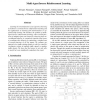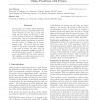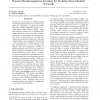ICMLA
2010
13 years 9 months ago
2010
Learning the reward function of an agent by observing its behavior is termed inverse reinforcement learning and has applications in learning from demonstration or apprenticeship l...
ICMLA
2010
13 years 9 months ago
2010
Recently, the so-called Support Feature Machine (SFM) was proposed as a novel approach to feature selection for classification, based on minimisation of the zero norm of a separati...
ICMLA
2010
13 years 9 months ago
2010
Abstract--Learning multiple related tasks from data simultaneously can improve predictive performance relative to learning these tasks independently. In this paper we propose a nov...
ICMLA
2010
13 years 9 months ago
2010
Quantum systems are promising candidates of future computing and information processing devices. In a large system, information about the quantum states and processes may be incomp...
ICML
2010
IEEE
13 years 9 months ago
2010
IEEE
This paper proposes a new method for comparing clusterings both partitionally and geometrically. Our approach is motivated by the following observation: the vast majority of previ...
ICML
2010
IEEE
13 years 9 months ago
2010
IEEE
In this paper, we consider online prediction from expert advice in a situation where each expert observes its own loss at each time while the loss cannot be disclosed to others fo...
ICML
2010
IEEE
13 years 9 months ago
2010
IEEE
In the realm of multilabel classification (MLC), it has become an opinio communis that optimal predictive performance can only be achieved by learners that explicitly take label d...
ICML
2010
IEEE
13 years 9 months ago
2010
IEEE
ICML
2010
IEEE
13 years 9 months ago
2010
IEEE
Many real-world datasets can be clustered along multiple dimensions. For example, text documents can be clustered not only by topic, but also by the author's gender or sentim...
ICML
2010
IEEE
13 years 9 months ago
2010
IEEE
Most learning to rank research has assumed that the utility of different documents is independent, which results in learned ranking functions that return redundant results. The fe...



